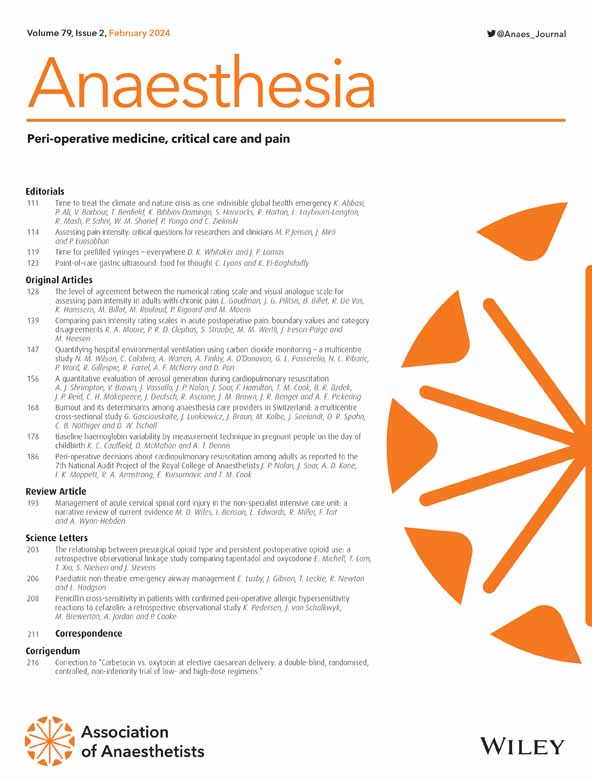谵妄的识别,预防和管理在重症监护病房在英格兰,威尔士和北爱尔兰:实践调查。
IF 6.9
1区 医学
Q1 ANESTHESIOLOGY
引用次数: 0
摘要
谵妄是急性脑功能障碍最常见的症状,在重症监护室中很普遍。这项工作是英国国家卫生和社会保健研究所研究资助的项目发展补助金的一部分,旨在确定预防、识别和管理英国ICU谵妄的最佳方法。这项调查旨在为当代实践提供一个基线。方法通过重症监护国家审计和研究中心病例组合规划,设计了一项结构化在线调查,并将其发送到英格兰、威尔士和北爱尔兰的所有icu。参与者被要求提供反映icu级别护理的回答。结果ICU参与者有效率为249/268(93%)。其中,222/249 (89%)ICU常规筛查谵妄,208/222(94%)使用CAM-ICU工具。125/249 (50%) icu采用了谵妄护理包,但81/125(68%)的icu表示并非所有患者都如此。抗精神病药物和苯二氮卓类药物通常用于治疗谵妄。所有答复者都表示,早期动员;早期拔除有创导尿管;助听器/眼镜保养;定时定量;白天活动作为非药物性谵妄管理策略。195/249名(79%)应答者报告了常规或特定病例的加强随访。只有一半的英国ICU使用标准化护理包来预防和管理ICU谵妄,执行不一致。未来的工作应侧重于制定和评估循证和可持续的一揽子护理方案。本文章由计算机程序翻译,如有差异,请以英文原文为准。
Delirium identification, prevention and management in intensive care units in England, Wales and Northern Ireland: a survey of practice.
INTRODUCTION
Delirium is the most common sign of acute brain dysfunction and is prevalent in ICUs. This work is part of a UK National Institute of Health and Social Care Research-funded Programme Development Grant to identify optimal approaches to prevent, identify and manage ICU delirium in the UK. This survey aimed to provide a baseline for contemporary practice.
METHODS
A structured online survey was designed and sent to all ICUs in England, Wales and Northern Ireland, identified through the Intensive Care National Audit and Research Centre Case Mix Programme. Participants were asked to provide a response that reflected ICU-level care.
RESULTS
The ICU participant response rate was 249/268 (93%). Of these, 222/249 (89%) ICUs screened for ICU delirium routinely and 208/222 (94%) used the CAM-ICU tool. Delirium care packages were applied by 125/249 (50%) ICUs, but 81/125 (68%) conveyed that this was not consistent for all patients. Both antipsychotics and benzodiazepines are used commonly to manage delirium. All respondents stated that early mobilisation; early removal of invasive catheters; maintenance of hearing aids/glasses; regular mealtimes; and daytime activity were used as non-pharmaceutical delirium management strategies. Enhanced follow-up was reported by 195/249 (79%) respondents, either routinely or for selected cases.
DISCUSSION
Only half of UK ICUs use a standardised care package to prevent and manage ICU delirium, with inconsistent implementation. Future work should focus on the development and evaluation of an evidence-based and sustainable care package.
求助全文
通过发布文献求助,成功后即可免费获取论文全文。
去求助
来源期刊

Anaesthesia
医学-麻醉学
CiteScore
21.20
自引率
9.30%
发文量
300
审稿时长
6 months
期刊介绍:
The official journal of the Association of Anaesthetists is Anaesthesia. It is a comprehensive international publication that covers a wide range of topics. The journal focuses on general and regional anaesthesia, as well as intensive care and pain therapy. It includes original articles that have undergone peer review, covering all aspects of these fields, including research on equipment.
 求助内容:
求助内容: 应助结果提醒方式:
应助结果提醒方式:


